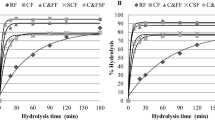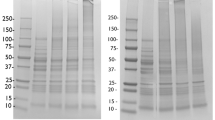Abstract
Flour from grass pea, a legume that is adapted to arid conditions containing high levels of proteins, was characterized according to microstructure, some functional properties and digestibility. Microstructural results showed that grass pea starch granules appeared surrounded by an integral matrix with heterogeneous sizes from 6 to 30 µm. Thermal properties displayed a single endothermic transition corresponding to starch gelatinization transition. The digestibility of starch was 79.6%, expressed as the ratio of non-resistant starch to the total amount of resistant and non-resistant starch. The flour was also relatively rich in phenolic substances possessing antioxidant properties as demonstrated by the 2-diphenyl-1-picrylhydrazyl radical method. Adult and elderly in vitro digestion demonstrated that proteins were easily digested. These findings suggest that this legume is suitable for feeding of a large spectrum of population, being endowed with attractive properties that make it potential enough as functional food.




Similar content being viewed by others
References
Kumar S, Bejiga G, Ahmed S, Nakkoul H, Sarker A (2011) Genetic improvement of grass pea for low neurotoxin (β-ODAP) content. Food Chem Toxicol 49:589–600
Yan ZY, Spencer PS, Li ZX, Liang YM, Wang YF, Wang CY, Li FM (2006) Lathyrus sativus (grass pea) and its neurotoxin ODAP. Phytochemistry 67:107–121
Jiao CJ, Jiang JL, Ke LM, Cheng W, Li FM, Li ZX, Wang CY (2011) Factors affecting β-ODAP content in Lathyrus sativus and their possible physiological mechanisms. Food Chem Toxicol 49:543–549
Rizzello CG, Hernández-Ledesma B, Fernández-Tomé S, Curiel JA, Pinto D, Marzani B, Coda R, Gobbetti M (2015) Italian legumes: effect of sourdough fermentation on lunasin-like polypeptides. Microb Cell Fact 14:168–188
Mariniello L, Giosafatto CVL, Di Pierro P, Sorrentino A, Porta R (2007) Synthesis and resistance to in vitro proteolysis of transglutaminase-crosslinked phaseolin, the major storage protein from Phaseolus vulgaris. J Agric Food Chem 55:4717–4721
Levi CS, Alvito P, Andrés A, Assunção R, Barberá R et al (2017) Extending in vitro digestion models to specific human populations: perspectives, practical tools and bio-relevant information. Trends Food Sci Technol 60:52–63
Nagler RM, Hershkovich O (2005) Relationships between age, drugs, oral sensorial complaints and salivary profile. Arch Oral Biol 50:7–16
Levi CS, Lesmes U (2014) Bi-compartmental elderly or adult dynamic digestion models applied to interrogate protein digestibility. Food Funct 5:2402–2409
AACC International (1999) approved methods of analysis. 11th edn. Method 44-15.02. Moisture–Air-Oven Methods. Approved November 3, Method 02-52.01. Hydrogen-ion activity (pH)—electrometric method; St. Paul, MN, U.S.A
Romano A, Di Luccia A, Romano R, Sarghini F, Masi P (2015) Microscopic and thermal characteristics of experimental models of starch, gliadins, glutenins and gluten from semolina. Chem Eng Trans 43:163–168
D’Appolonia BL (1977) Rheological and baking studies of legume-wheat flour blends. Cereal Chem 54:53–59
Romano A, Giosafatto CVL, Masi P, Mariniello L (2015) Impact of dehulling on the physico-chemical properties and in vitro protein digestion of common beans (Phaseolus vulgaris L.). Food Funct 6:1345–1351
Romano A, Mackie A, Farina F, Aponte M, Sarghini F, Masi P (2016) Characterisation, in vitro digestibility and expected glycemic index of commercial starches as uncooked ingredients. J Food Sci Technol 53:4126–4134
AACC International (2002) Approved Methods of Analysis, 11th edn. Method 32-40.01. Resistant Starch in Starch Samples and Plant Materials. Approved October 17, AACC International, St. Paul
Kjeldahl J (1883) Neue Methode zur Bestimmung des Stickstoffs in organischen Körpern. Fresenius’ J Anal Chem 22:66–382
de Toledo NM, Rocha LC, da Silva AG, Canniatti Brazaca SG (2013) Interaction and digestibility of phaseolin/polyphenol in the common bean. Food Chem 138:776–780
Kähkönen MP, Hopia AI, Vuorela HJ, Rauha J, Pihlaja K, Kujala TS, Heinonen M (1999) Antioxidant activity of plant extracts containing phenolic compounds. J Agric Food Chem 47:3954–3962
Giosafatto CVL, Di Pierro P, Gunning AP, Mackie A, Porta R, Mariniello L (2014) Trehalose-containing hydrocolloid edible films prepared in the presence of transglutaminase. Biopolymers 101:931–937
Giosafatto CVL, Rigby NM, Wellner N, Ridout M, Husband F, Mackie A (2012) Microbial transglutaminase-mediated modification of ovalbumin. Food Hydrocolloid 26:261–267
Laemmli UK (1970) Cleavage of structural proteins during the assembly of the head of bacteriophage T4. Nature 227:680–685
Ma Z, Boye JI, Simpson BK, Prasher SO, Monpetit D, Malcolmson L (2011) Thermal processing effects on the functional properties and microstructure of lentil, chickpea, and pea flours. Food Res Int 44:2534–2544
Gularte MA, Gómez M, Rosell CM (2012) Impact of legume flours on quality and in vitro digestibility of starch and protein from gluten-free cakes. Food Bioprocess Tech 5:3142–3150
Wani IA, Sogi DS, Wani AA, Gill BS (2013) Physico-chemical and functional properties of flours from Indian kidney bean (Phaseolus vulgaris L.) cultivars. LWT Food Sci Technol 53:278 – 284
Doporto MC, Dini C, Mugridge A, Viña SZ, García MA (2012) Physicochemical, thermal and sorption properties of nutritionally differentiated flours and starches. J Food Eng 113:569–576
Blanchard C, Labouré H, Verel A, Champion D (2012) Study of the impact of wheat flour type, flour particle size and protein content in a cake-like dough: proton mobility and rheological properties assessment. J Cereal Sci 56:691–698
Rodríguez-Miranda J, Ruiz-López II, Herman-Lara E, Martínez-Sánchez CE, Delgado-Licon E, Vivar-Vera MA (2011) Development of extruded snacks using taro (Colocasia esculenta) and nixtamalized maize (Zea mays) flour blends. LWT Food Sci Technol 44:673–680
Siddiq M, Ravi R, Harte JB, Dolan KD (2010) Physical and functional characteristics of selected dry bean (Phaseolus vulgaris L.) flours. LWT Food Sci Technol 4:232–237
Protonotariou S, Drakos A, Evageliou V, Ritzoulis C, Mandala I (2014) Sieving fractionation and jet mill micronization affect the functional properties of wheat flour. J Food Eng 134:24–29
Romano A, Masi P, Aversano R, Carucci F, Palomba S, Carputo D (2018) Microstructure and tuber properties of potato varieties with different genetic profiles. Food Chem 239:789–796
Korus J, Witczak M, Juszczak L, Ziobro R (2008) Grass pea (Lathyrus sativus L.) starch as an alternative for cereal starches: Rheological properties and retrogradation susceptibility. J Food Eng 88:528–534
Henshaw FO, McWatters KH, Akingbala JO, Chinnan MS (2003) Thermal properties of cowpea flour: a study by differential scanning calorimetry. Nahrung 47:161–165
Rosa MJ, Ferreira RB, Teixeira AR (2000) Storage proteins from Lathyrus sativus seeds. J Agric Food Chem 48:5432–5439
Chattopadhyay A, Subba P, Pandey A, Bhushan D, Kumar R, Datta A, Chakraborty S, Chakraborty N (2011) Analysis of the grasspea proteome and identification of stress-responsive proteins upon exposure to high salinity, low temperature, and abscisic acid treatment. Phytochemistry 72:1293–1307
Desphande SS, Campbell CG (1992) Genotype variation in BOAA, condensed tannins, phenolics and enzyme inhibitors of grass pea (Lathyrus sativus). Can J Plant Sci 72:1037–1047
Devasagayam TP, Tilak JC, Boloor KK, Sane KS, Lele RD (2004) Free radicals and antioxidants in human Health: Current status and future prospects. J Assoc Physicians India 52:795–804
Tamburino R, Guida V, Pacifico S, Rocco M, Zarelli A, Parente A, Di Maro A (2012) Nutritional values and radical scavenging capacities of grass pea (Lathyrus sativus L.) seeds in Valle Agricola district, Italy. Aust J Crop Sci 6:149–156
Aprianita A, Purwandari U, Watson B, Vasiljevic T (2009) Physico-chemical properties of flours and starches from selected commercial tubers available in Australia. Int Food Res J 16:507–520
Liu Q, Donner E, Yin Y, Huang RL, Fan MZ (2006) The physicochemical properties and in vitro digestibility of selected cereals, tubers and legumes grown in China. Food Chem 99:470–477
Pratap Rudra MP, Raghuveer Singh M, Junaid MA, Jyothi P, Rao SLN (2004) Metabolism of dietary ODAP in humans may be responsible for the low incidence of neurolathyrism. Clin Biochem 37:318–322
Ravindranath V (2002) Neurolathyrism: mitochondrial dysfunction in excitotoxicity mediated by l-β-oxalyl aminoalanine. Neurochem Intern 40:505–509
Acknowledgements
The authors thank Elisabetta Pucci and Maria Fenderico for their technical collaboration.
Author information
Authors and Affiliations
Corresponding author
Ethics declarations
Conflict of interest
None.
Compliance with ethics requirements
This article does not contain any studies with human or animal subjects.
Rights and permissions
About this article
Cite this article
Romano, A., Giosafatto, C.V.L., Al-Asmar, A. et al. Grass pea (Lathyrus sativus) flour: microstructure, physico-chemical properties and in vitro digestion. Eur Food Res Technol 245, 191–198 (2019). https://doi.org/10.1007/s00217-018-3152-y
Received:
Accepted:
Published:
Issue Date:
DOI: https://doi.org/10.1007/s00217-018-3152-y




